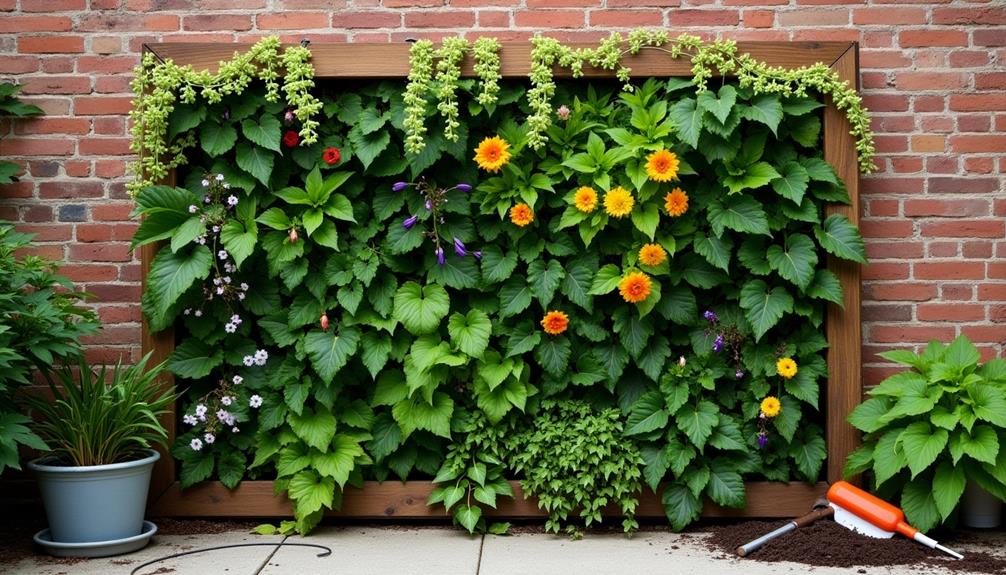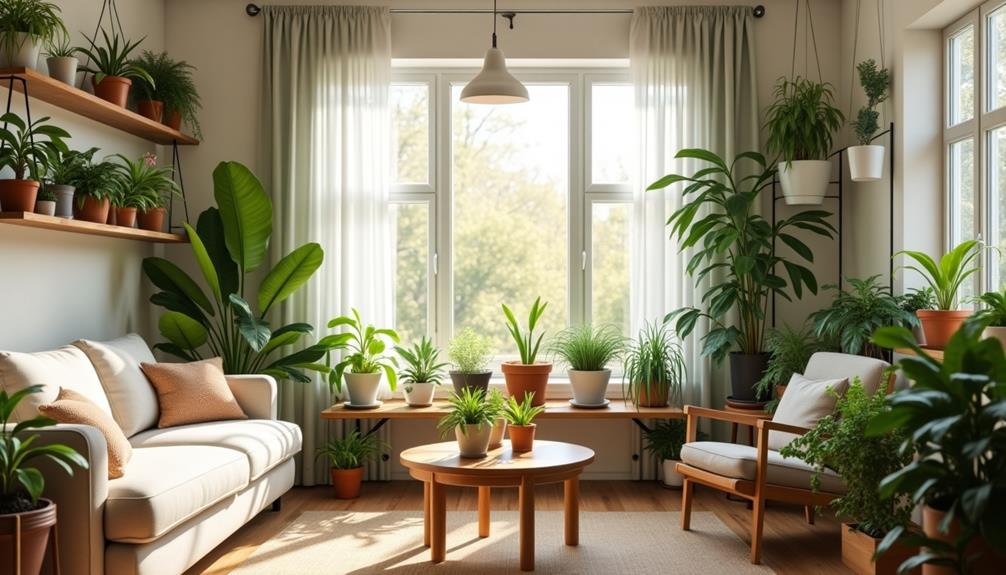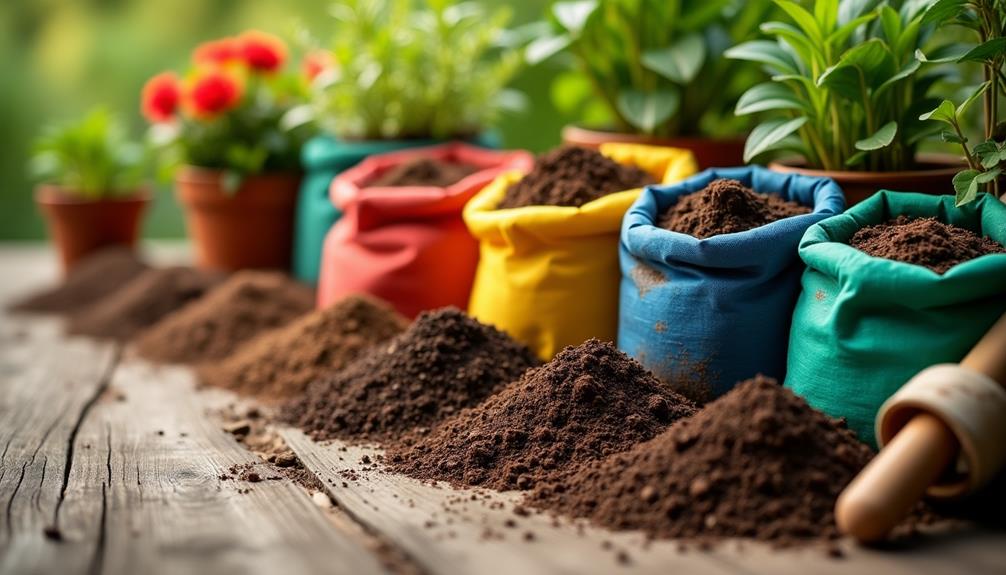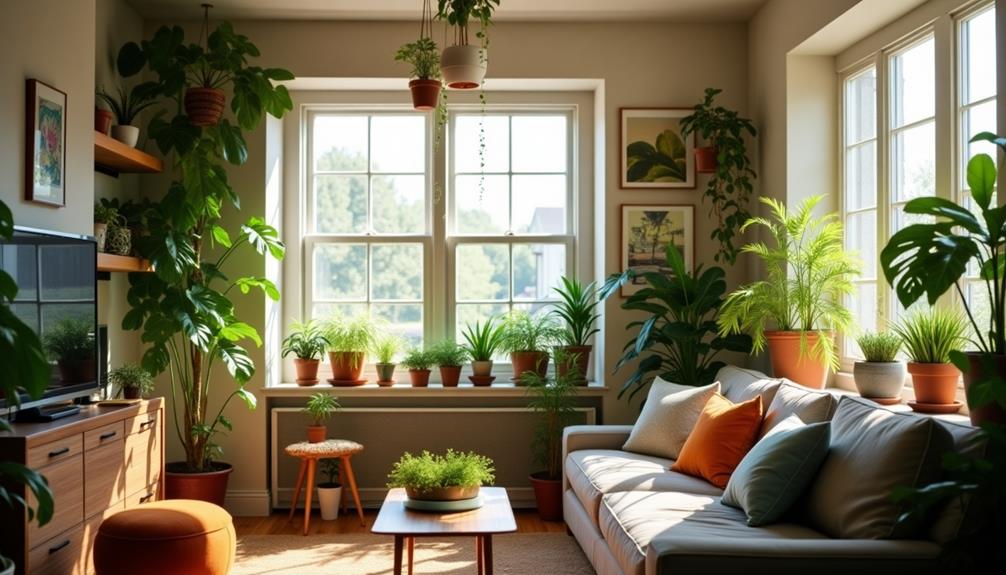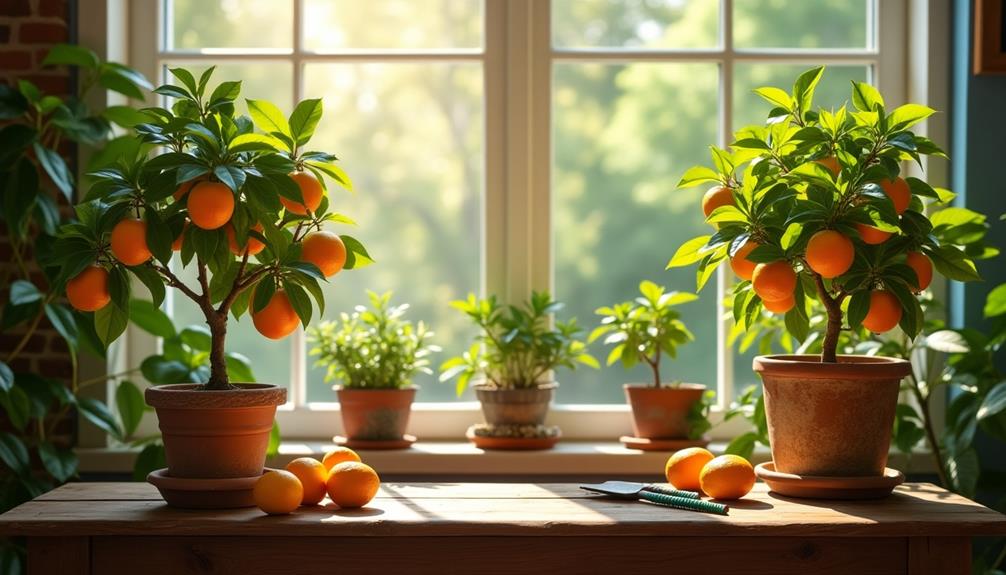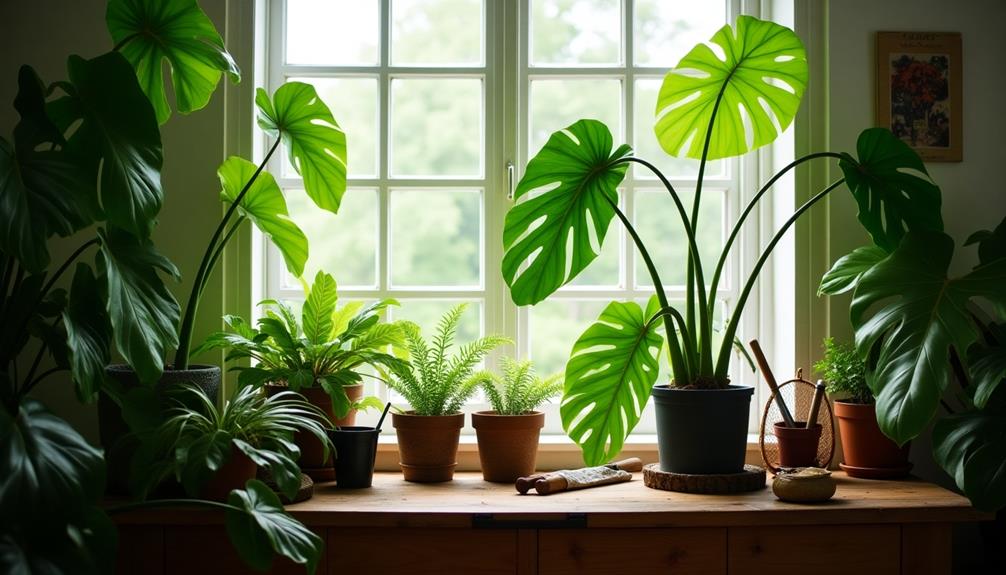If you're considering a vertical garden wall, you're in for an enriching experience that can transform your space. By choosing the right location and selecting appropriate plants, you can create a thriving green oasis. You'll need some essential materials, but don't worry; the process is straightforward. As you plan this project, think about how to maintain it effectively and keep it visually appealing. Curious about the specific steps to ensure your vertical garden wall flourishes? Let's explore the details that will set your project up for success.
Benefits of Vertical Gardens
Vertical gardens offer a way to maximize space and bring nature into your home or office. By incorporating greenery vertically, you not only enhance the aesthetic appeal but also contribute to your well-being.
Imagine walking into a room filled with lush plants that purify the air, reducing indoor pollutants and improving air quality. This air purification can lead to a healthier environment for you and your loved ones.
Moreover, vertical gardens play a significant role in stress reduction. The sight of vibrant plants can calm your mind, making them ideal for urban gardening, where space is often limited.
You'll find that even a small vertical garden can provide a sense of tranquility amidst the hustle and bustle of city life.
Additionally, these gardens promote biodiversity and sustainability practices. By choosing native plants, you can attract local wildlife, fostering a balanced ecosystem right in your backyard.
Ultimately, vertical gardens are a smart way to optimize your space while embracing environmental awareness. They serve as a beautiful reminder of nature's importance, encouraging you to engage with sustainable living and cherish the beauty around you.
Choosing the Right Location
Before you start building your vertical garden, it's crucial to choose the right location to ensure your plants thrive.
Begin by assessing sunlight exposure. Most plants require at least six hours of direct sunlight each day, so find a spot that gets plenty of light. If your wall faces north or is shaded by nearby structures, you might need to adjust your plant choices accordingly.
Next, evaluate the wall conditions. The surface should be sturdy enough to support your garden's weight, and it's important to consider its material. Brick or concrete walls typically work best, while wooden surfaces may require additional treatment to prevent rot.
Make sure the wall can handle moisture without damaging the structure behind it.
Also, think about accessibility. You'll want to reach your garden easily for maintenance tasks like watering and pruning.
Lastly, consider the aesthetic appeal. Choose a location that complements your outdoor space, creating a harmonious look that enhances your property.
Selecting Suitable Plants
Choosing the right plants is essential for a thriving vertical garden. Start by considering your local climate and the plant hardiness zone in your area. This will help you choose plants that can withstand the temperature fluctuations and weather conditions unique to your region.
Next, think about the light requirements of your vertical garden. Will your wall get full sun, partial shade, or full shade? Different plants thrive in varying light conditions, so it's crucial to match your selections to the available sunlight.
For instance, succulents and herbs typically prefer bright, direct light, while ferns and certain shade-loving plants do better in lower light conditions.
Also, consider the growth habits of your chosen plants. Some may need more space and support, while others can thrive in tighter spots. Mixing trailing plants with upright varieties can create a visually appealing tapestry.
Lastly, keep in mind maintenance requirements. Some plants are low-maintenance, while others might require more frequent watering and pruning.
Required Materials and Tools
To bring your vertical garden vision to life, you'll need a few key materials and tools. Start with vertical garden kits, which often include everything you need for installation. These kits typically come with wall mounted planters, soil, and a watering system, making setup easier.
Next, gather additional materials like a sturdy frame or grid to support your planters. Depending on your wall type, you might need anchors or screws to secure everything in place. Don't forget potting soil and a selection of plants that thrive in vertical setups. You may also want to include a watering can or hose, especially if your garden is on a larger scale.
Tools like a drill, level, and measuring tape will help you position your wall mounted planters accurately. A pair of scissors or pruning shears is essential for plant maintenance.
Lastly, gloves protect your hands while handling soil and plants. With these materials and tools in hand, you'll be well-prepared to create a stunning vertical garden that enhances your space beautifully.
Step-by-Step Installation
Now that you've gathered your materials, it's time to prepare the structure for your vertical garden wall.
You'll want to ensure it's sturdy enough to support the plants you choose.
Let's also go over some tips for selecting the right plants to make your garden flourish.
Gather Necessary Materials
Before diving into your vertical garden wall project, it's essential to gather all the necessary materials. Start by selecting a sturdy frame; wooden pallets, trellises, or metal grids work well.
If you're using vertical gardening techniques, ensure your frame can support the weight of the plants and soil.
Next, choose the right containers or pockets for your plants. Hanging planters, felt pockets, or repurposed bottles are great options, especially when you're committed to sustainable gardening practices.
Don't forget to pick up potting soil that's suitable for your chosen plants, along with a slow-release fertilizer to promote healthy growth.
You'll also need a watering system. Consider a drip irrigation setup for efficiency, or simply gather a watering can or hose for manual watering.
Make sure you have basic tools, such as a drill or screwdriver, to secure your structure in place.
Prepare the Structure
Preparing the structure for your vertical garden wall involves a few straightforward steps that ensure stability and success. First, choose the right frame materials. You can use wood, metal, or PVC, but make sure they're durable enough to support the weight of the plants and soil. If you're using wood, opt for treated lumber to resist moisture.
Next, measure your wall space accurately. Mark where you'll attach the frame, ensuring it's level. This step is crucial for wall stability, as an uneven frame can lead to structural problems down the line.
Once you've marked the spots, secure the frame to the wall using appropriate anchors or screws that can handle the load. If you're building a freestanding structure, ensure it has a solid base. You might need to add cross-bracing for extra support.
After securing the frame, double-check that everything is stable before moving on to the next steps. This careful preparation will give you a strong foundation for your vertical garden, allowing your plants to thrive beautifully in their new vertical home.
Plant Selection Tips
With your frame securely in place, the next step is selecting the right plants for your vertical garden wall.
Start by considering native plants, as they thrive in your local climate and require less maintenance. They're also more resistant to pests and diseases, making them an ideal choice for a sustainable garden.
Next, think about the light conditions your wall receives. If it's in a sunny spot, opt for drought-tolerant plants like succulents or herbs.
For shadier areas, select ferns or shade-loving plants that can flourish without direct sunlight.
Don't forget to incorporate seasonal varieties. Mixing in plants that bloom at different times of the year will ensure your vertical garden remains visually appealing throughout all seasons.
This way, you'll enjoy vibrant colors and textures year-round.
Maintenance Tips
Now that you've installed your vertical garden wall, keeping it thriving is key.
You'll need to establish a solid watering schedule, tackle any pest issues, and learn effective pruning techniques.
Let's explore these essential maintenance tips to ensure your garden stays lush and beautiful.
Watering Schedule Essentials
Establishing a consistent watering schedule is crucial for the health and vibrancy of your vertical garden wall. To ensure your plants thrive, consider using a drip irrigation system. This method delivers water directly to the roots, minimizing waste and promoting efficient moisture retention.
Start by assessing the specific needs of your plants. Different species may require varying amounts of water. Generally, you should aim to water your vertical garden wall early in the morning or late in the evening to reduce evaporation.
Monitor the moisture level of your wall regularly. You can do this by sticking your finger into the soil; if it feels dry up to your first knuckle, it's time to water. During particularly hot or dry spells, you may need to increase your watering frequency.
Keep an eye on the drainage as well. Ensure your setup allows excess water to escape, preventing root rot.
Lastly, adjust your watering schedule with the changing seasons. Plants typically need less water in the cooler months. By staying attentive to your watering schedule, you'll help your vertical garden wall flourish beautifully.
Pest Control Strategies
To keep your vertical garden wall thriving, it's essential to implement effective pest control strategies.
Start with preventative measures, like setting up insect barriers to shield your plants from unwanted pests. Regular pest monitoring is crucial; check your plants frequently for any signs of infestation.
Utilize natural predators, such as ladybugs and lacewings, which can help keep harmful insects at bay.
Companion planting is another excellent strategy—planting species that repel pests or attract beneficial insects can create a balanced ecosystem in your vertical garden.
When needed, turn to organic repellents made from natural ingredients, ensuring that your pest control methods align with eco-friendly solutions.
If you notice an increase in pests, act quickly to tackle the issue before it escalates.
Pruning and Trimming Techniques
Maintaining a healthy vertical garden wall goes beyond pest control; regular pruning and trimming are key to promoting growth and aesthetics. Start by deadheading flowers as soon as they start to wilt. This practice encourages your plants to focus their energy on producing new blooms rather than on seed production. Use sharp, clean scissors or pruning shears to make precise cuts, ensuring you don't damage the surrounding plant.
Seasonal pruning is also essential for maintaining the shape and health of your vertical garden. In early spring or late fall, assess your plants and remove any dead or overgrown branches. This not only enhances the overall appearance but also improves air circulation and light penetration, which are vital for plant health.
Additionally, keep an eye on the growth patterns of your plants. If you notice any vines or branches taking over, don't hesitate to trim them back to encourage a balanced growth.
Regularly checking for dead or diseased foliage and removing it will help prevent the spread of pests and diseases. By incorporating these pruning and trimming techniques, you'll ensure your vertical garden wall remains vibrant and thriving all season long.
Creative Design Ideas
When it comes to designing your vertical garden wall, there are endless creative possibilities to explore. Start by choosing a cohesive color palette that complements your space. Consider vibrant greens mixed with pops of floral colors or opt for a more subdued scheme with earthy tones. This won't only enhance the aesthetic appeal but also create a calming atmosphere.
Next, think about incorporating unique textures. Mix various plant types, like ferns, succulents, and trailing vines, to add depth and interest. You can also use different materials for your wall, such as wood, metal, or even recycled pallets, to create a visually striking backdrop.
Don't shy away from personal touches—add decorative elements like hanging planters, fairy lights, or artwork to truly make the space your own. Vertical gardening isn't just about plants; it's also an opportunity to showcase your personality and style.

